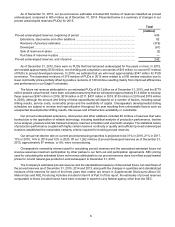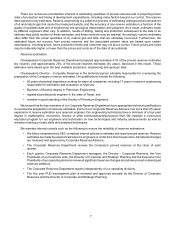Chesapeake Energy 2015 Annual Report Download - page 20
Download and view the complete annual report
Please find page 20 of the 2015 Chesapeake Energy annual report below. You can navigate through the pages in the report by either clicking on the pages listed below, or by using the keyword search tool below to find specific information within the annual report.16
Discharges into Waters
The federal Water Pollution Control Act, or the Clean Water Act (CWA), and analogous state laws impose
restrictions and strict controls regarding the discharge of pollutants into state waters as well as U.S. waters. In June
2015, the EPA and USACE jointly published a rule regarding the definition of waters of the United States that substantially
expands the waters regulated under the CWA. Implementation of the rule was temporarily stayed in October 2015 by
the U.S. Court of Appeals for the Sixth Circuit, pending further action. The placement of dredge or fill material into
jurisdictional water or U.S. wetlands is prohibited, except in accordance with the terms of a permit issued by the USACE.
The discharge of pollutants into regulated waters is prohibited, except in accordance with the terms of a permit issued
by the EPA or a state agency delegated with EPA's authority. In April 2015, the EPA also published proposed pretreatment
standards for disposal of wastewater produced from shale gas operations to publicly owned treatment works (POTWs).
Further, Chesapeake's corporate policy prohibits discharge of produced water to surface waters. Spill prevention,
control and countermeasure regulations require appropriate containment berms and similar structures to help prevent
the contamination of regulated waters in the event of a hydrocarbon tank spill, rupture or leak. In addition, the CWA
and analogous state laws require individual permits or coverage under general permits for discharges of storm water
runoff from certain types of facilities and construction activities.
The Oil Pollution Act of 1990 (OPA) establishes strict liability for owners and operators of facilities that release oil
into waters of the United States. The OPA and its associated regulations impose a variety of requirements on responsible
parties related to the prevention of oil spills and liability for damages resulting from such spills. A ''responsible party''
under the OPA includes owners and operators of certain onshore facilities from which a release may affect waters of
the United States.
Health and Safety
The Occupational Safety and Health Act (OSHA) and comparable state laws regulate the protection of the health
and safety of our employees. The federal Occupational Safety and Health Administration has established workplace
safety standards that provide guidelines for maintaining a safe workplace in light of potential hazards, such as employee
exposure to hazardous substances. OSHA also requires employee training and maintenance of records, and the OSHA
hazard communication standard and EPA community right-to-know regulations under the Emergency Planning and
Community Right-to-Know Act of 1986 require that we organize and/or disclose information about hazardous materials
used or produced in our operations.
Endangered Species
The Endangered Species Act (ESA) restricts activities that may affect areas that contain endangered or threatened
species or their habitats. While some of our assets and lease acreage may be located in areas that are designated as
habitats for endangered or threatened species, we believe that we are in material compliance with the ESA. However,
as a result of a settlement reached in 2011, the U.S. Fish and Wildlife Service is required to make a determination on
the listing of more than 250 species as endangered or threatened over the next several years. The designation of
previously unidentified endangered or threatened species in areas where we intend to conduct construction activity or
the imposition of seasonal restrictions on our construction or operational activities could materially limit or delay our
plans.
Global Warming and Climate Change
At the federal level, EPA regulations require us to establish and report an inventory of greenhouse gas emissions.
Legislative and regulatory proposals for restricting greenhouse gas emissions or otherwise addressing climate change,
such as the President’s Climate Action Plan which calls for reducing methane emissions, could require us to incur
additional operating costs and could adversely affect demand for the oil and natural gas that we sell. As discussed
above, the EPA proposed new standards of performance limiting methane emissions from oil and gas sources in 2015.
The potential increase in our operating costs could include new or increased costs to (i) obtain permits, (ii) operate
and maintain our equipment and facilities (through the reduction or elimination of venting and flaring of methane), (iii)
install new emission controls on our equipment and facilities, (iv) acquire allowances authorizing our greenhouse gas
emissions, (v) pay taxes related to our greenhouse gas emissions and (vi) administer and manage a greenhouse gas
emissions program. In addition to these federal actions, various state governments and/or regional agencies may
consider enacting new legislation and/or promulgating new regulations governing or restricting the emission of
greenhouse gases from stationary sources such as our equipment and operations.
























